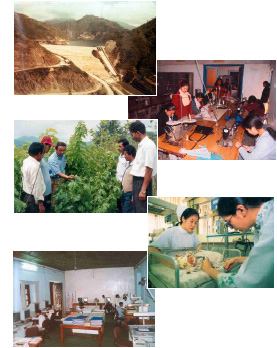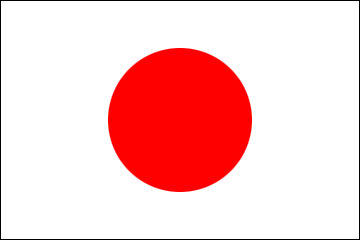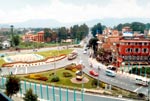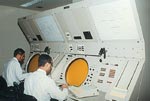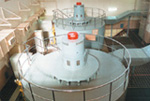General Introduction of Japan's ODA to Nepal
2020/6/12
There have been close and friendly relationships between Japan and Nepal for many years. This landlocked country, Nepal, having no direct access to the sea, is one of the least developed countries in South Asia. In this severe condition the needs of her socio-economic development still remain. Since the restoration of democracy in 1990 Nepal has been striving towards economic development through the process of liberalization. It has been a privilege to Japan to participate in the economic development programs of Nepal since 1954. Grant and loan aid started soon after the opening of the Embassy in Kathmandu in 1968. At present Japan is one of the top donors to Nepal and involved in every important sector of the economy. Until Japan's fiscal year 2009, the Government of Japan had provided a total assistance of ¥308.59 billion that constitutes grants (¥186.43 billion), loans (¥63.88 billion) and technical assistance (¥58.27 billion) mainly in the following sectors.
- Human Resources Development
- Social Sector (Health and Education)
- Agriculture Development
- Economic Infrastructure
- Environmental Conservation
- Cultural Grant Aid
|
|
Human Resources Development
Realizing the fact that human resources development is indispensable for the self-supporting development of Nepal, and efficient management and utilization of natural resources, the Government of Japan has been providing technical assistance to Nepal in implementing and managing technical cooperation projects. Japan has dispatched 1,539 technical experts and 933 Japan Overseas Cooperation Volunteers (JOCV). Dispatching of senior volunteers to Nepal started in 1995 and so far 82 of them have served in different areas in Nepal. Similarly, the number of Nepalese trainees accepted in Japan was 3,803 (as of JFY 2007).
|
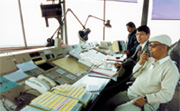 A JICA expert at control tower
A JICA expert at control tower
console at the TIA constructed
under Japan's grant aid
|
 Design instruction for Nepalese
Design instruction for Nepalese
art craft at ACT by JOCV |
Social Sector (Health and Education)
Considering the fact that Nepal has a high incidence of diarrhea caused by unclean water which is also one of the causes of the country's high infant mortality rate, Japan has extended cooperation for safe drinking water supply, maternity health care, providing polio vaccine and other medical care programs for the last few years. The construction of T.U. Teaching Hospital, National Tuberculosis Center and assistance to Kanti Children's Hospital are the main projects that have been implemented successfully under Japan's ODA.
Recognizing the vital importance of providing educational opportunity for children as the prerequisite and backbone to socio-economic development of the country, the Government of Japan has provided grant assistance for the construction of approximately 8,028 classrooms in primary schools under BPEP I (94-98), BPEP II (99-02) and EFA (03-05).
|
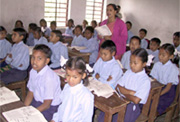 Children in the classroom of Bharatpur
Children in the classroom of Bharatpur
Primary School constructed
under Japan's grant aid
|
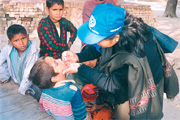 A volunteer administrating polio
A volunteer administrating polio
drops to the children in Nawalparasi |
Agriculture Development
Agriculture is the main sector in Nepal consisting of nearly 40% of GDP, and 80% of the population live on agriculture. However, the traditional farming method is still prevalent which is not cost effective and is not conducive to substantially improving the living standard. Under such circumstances, the agriculture sector has not been able to contribute greatly to the economic growth of the country. Since 1977 Japan has been providing assistance in such areas as improving agricultural infrastructure, in improving high value agriculture products as well as in the development and diffusion of agricultural production technologies in order to increase employment opportunities and to raise the income level of farmers.
Starting with the cooperation in Janakpur Agriculture Development Project (JADP), Japanese assistance has been valuable in the field of fisheries, sericulture, horticulture and irrigation.
|
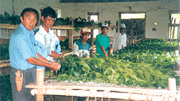 Horticulture Development Center
Horticulture Development Center
|
 Sericulture Promotion Project
Sericulture Promotion Project |
Environmental Conservation
In view of Nepal's population growth and poverty, the country has a considerable problem of environmental degradation, particularly deforestation. In this regard, Japan gives priority to assisting the proper utilization of natural resources for environmental improvement and disaster mitigation. Japan has extended assistance for projects in the areas of disaster mitigation, forest/watershed conservation, studies of Fewa Lake in Pokhara, as well as community development.
|
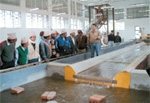 Godawari Laboratory
Godawari Laboratory
|
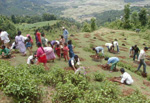 Tree Plantation by Local Community
Tree Plantation by Local Community |
|
Disaster Mitigation Support Program (DMSP) Project
|
Cultural Grant Aid
As one of the international exchanges in the field of culture, since 1977 Japan has been providing cultural grant aid to Nepal with the aim of promoting cultural, educational, and research activities, including the preservation of cultural assets and relics and the holding of cultural performances and exhibitions. The recent aid in this scheme are micrographic equipment to Nepal National Library, dubbing equipment and educational programs to Nepal Television, display equipment to Buddhist Art Gallery at National Museum, sports equipment to National Sports Council and printing equipment to Royal Nepal Academy.
|
 Dharma-dhatu Mandala at Mandala
Dharma-dhatu Mandala at Mandala
Gallary, National Museum
|
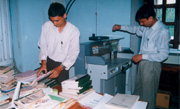 Repairing books by a paper guillotine
Repairing books by a paper guillotine
machine at the National Library |
